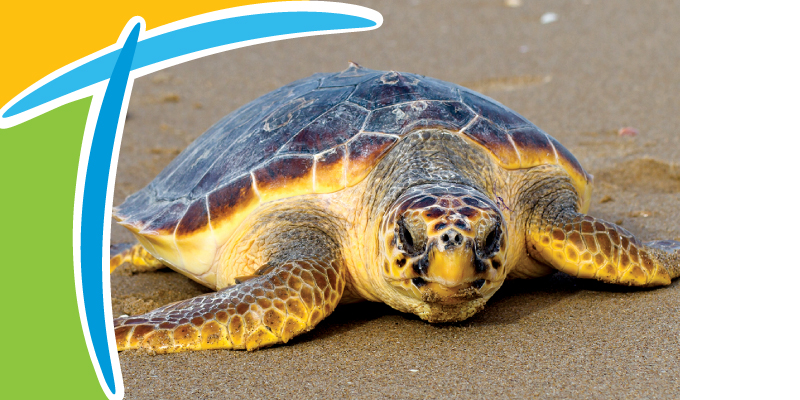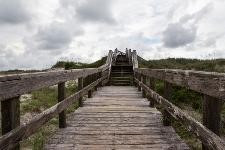Sea Turtles Love It Here
 August 12, 2020 – It’s Summertime on Florida’s Space Coast and that means many wonderful things—from the beauty of bioluminescence in our Lagoon to dark night sky astronomy adventures to the ongoing saga on our sea turtle nesting beaches. And at this time of the year, it’s important to remember to be especially watchful of little hatchlings struggling to make their way to the sea.
August 12, 2020 – It’s Summertime on Florida’s Space Coast and that means many wonderful things—from the beauty of bioluminescence in our Lagoon to dark night sky astronomy adventures to the ongoing saga on our sea turtle nesting beaches. And at this time of the year, it’s important to remember to be especially watchful of little hatchlings struggling to make their way to the sea.
Update August 13, 2020 – Steve Johnson, Associate Professor at the University of Florida, Department of Wildlife Ecology, identified the turtle we have pictured as a Loggerhead rather than a Green Turtle. Thanks for the information!
Common to our area are these nesting mamas:
• Loggerheads: named for their large, block-shaped heads with strong jaw muscles for crushing benthic invertebrates, Loggerheads (shown above) are the most common sea turtle species on Florida’s nesting beaches.
• Greens: largely vegetarian, Greens can be spotted foraging in seagrass meadows.
• Leatherbacks: the largest species of sea turtle, Leatherbacks are covered with a somewhat flexible “leathery” shell, rather than a hard shell.
• Kemp’s Ridley: the smallest and most endangered marine turtle, a Kemp’s Ridley can sometimes be seen foraging in nearshore areas but rarely nest on Florida’s beaches.
• Hawksbill: named for their pointed beaks, the Hawksbill is mostly tropical but sometimes appears in the southern waters of Florida and even more rarely actually nest here.
All of Florida’s sea turtles are in danger of extinction, but there are simple steps Florida’s residents and visitors can take to help these remarkable animals. It’s good for all of us to have a reminder of the best ways to share the beauty of our area with these remarkable creatures.

Credit: Margaret Lamont
1. Turn off lights, use wildlife-safe lighting, and avoid bonfires near beaches. Sea turtles can become disoriented by artificial lighting. Refrain from using outdoor lights when turtles are nesting and hatching, from May–October. If you must have outdoor lighting, use fixtures that shield bulbs on the top and sides so light is directed downward and is not visible from the beach; use fixtures that are mounted low to the ground; or use turtle-friendly bulbs that are less visible to sea turtles (long-wavelength producing orange, amber, or red light).
2. Keep garbage off the beach and out of the water. Sea turtles can become entangled in fishing line, ropes, and monofilament. They can also ingest plastic garbage that they mistake for food.

Credit: Ximena Zornosa (left) and Tyler Jones, UF/IFAS (right)
3. Do not disturb nesting or hatching sea turtles or sea turtle nests. Stay at least 50 yards from any turtles on the beach, turn off all flashlights, lanterns, cellphone screens, or other light sources if it is after sunset. Do not disturb marked nests.
4. Protect seagrass beds. Seagrass beds are important nursery grounds for juvenile sea turtles providing shelter and necessary food sources. Gouging seagrass beds and creating trenches with boat propellers destroys this essential habitat.
5. Remove recreational equipment and furniture from the beach at night. Adult female sea turtles crawl onto beaches to lay their eggs at night and can become entangled in recreational equipment and furniture left on the beach. Newly hatched sea turtles emerging from their nests can become entangled as they crawl to the water.

Credit: Tyler Jones, UF/IFAS
6. Use designated beach walkovers or access points. Dunes help stabilize the beach habitat that sea turtles use for nesting. If you walk over the dunes, you destroy the plants that hold the dunes in place. Without this vegetation, dunes are quickly eroded by wind, which ultimately leads to problems for turtles that become disoriented by lights.
7. Follow best fishing practices for sea turtles. Never leave a fishing line unattended, and always properly dispose of fishing lines and old hooks and lures in trash receptacles or recycling containers. If you hook a sea turtle or find one caught on fishing gear, immediately notify the Florida Fish & Wildlife Conservation Commission (FWC) by calling 1-888-404-FWCC.

Credit: UF/IFAS
8. Reduce polluted water run-off. To minimize the effects of water pollution, never fertilize or irrigate your lawn if rain is forecast within a few hours. Please consider landscaping with native plants that are adapted to the local growing conditions and less likely than non-native ornamentals to require extensive fertilization and irrigation.
9. Observe sea turtles from a safe distance when boating or jet-skiing. Drive slowly and navigate carefully in areas where sea turtles might be foraging, including shallow waters, reefs, and seagrass beds.
10. Learn all you can about these amazing animals. You’ll be both entranced and willing to take the simple steps to help them live full and glorious lives, returning to our beaches again and again to nest.
SOURCE: https://edis.ifas.ufl.edu/uw466
The resource for this article is from the Department of Wildlife Ecology and Conservation, UF/IFAS Extension. Contributors: Jessica E. Swindall, former graduate research assistant, Department of Wildlife Ecology and Conservation; Holly K. Ober, associate professor and Extension specialist, North Florida Research and Education Center; Margaret M. Lamont, biologist, US Geological Survey, Wetland and Aquatic Research Center; and Raymond R. Carthy, assistant unit leader, US Geological Survey—Florida Cooperative Fish & Wildlife Research Unit; UF/IFAS Extension
Additional Information
Florida Fish and Wildlife Conservation Commission. 2019a. Species of Sea Turtles Found in Florida. https://myfwc.com/research/wildlife/sea-turtles/florida/
Florida Fish and Wildlife Conservation Commission. 2019b. Threats to Sea Turtles. https://myfwc.com/research/wildlife/sea-turtles/threats/
National Oceanic and Atmospheric Administration. 2019. Sea Turtles. https://www.noaa.gov/education/resource-collections/marine-life-education-resources/sea-turtles
US Fish and Wildlife Service. 2019. General Sea Turtle Information. https://www.fws.gov/northflorida/SeaTurtles/seaturtle-info.htm







